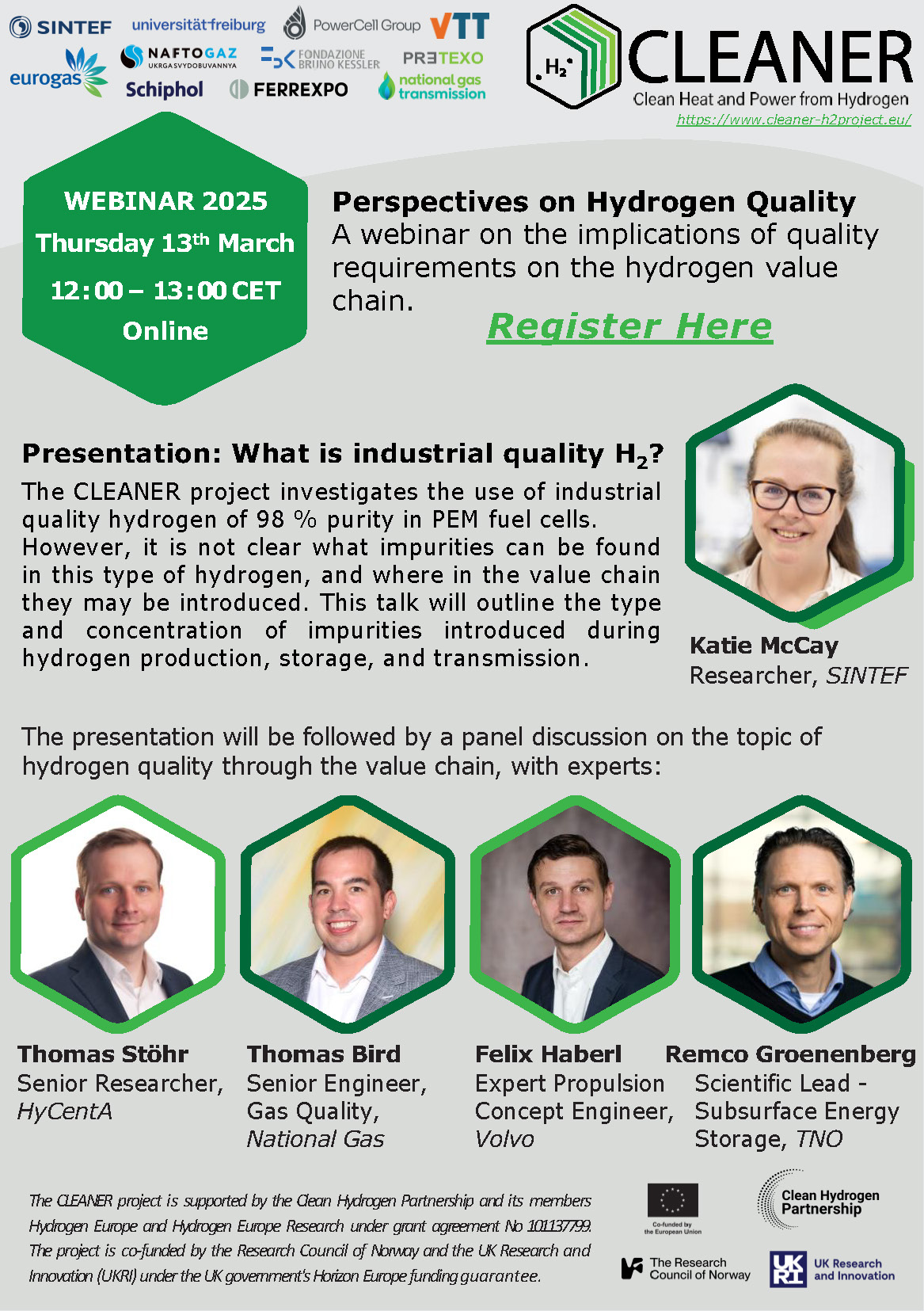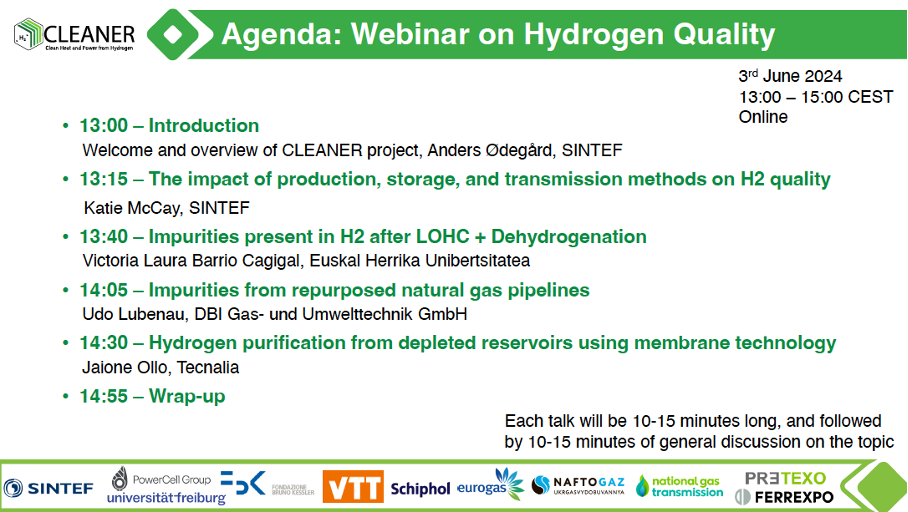PROJECT NEWS
Summary of the webinar on Hydrogen Quality - 13th March 2025
CLEANER YouTube channel - video of the recording
Anders Ødegård introduced the CLEANER project, aiming to operate a large fuel cell for 5000 hours using industrial quality hydrogen, increase its impurity tolerance, reduce operational costs, and improve efficiency. The project includes developing catalysts and membranes, cell and stack testing, modelling, and economic/environmental analysis. Results will be disseminated throughout the project.
Katie McCay presented a study on industrial quality hydrogen, highlighting that it is not currently well-specified. The study aimed to identify potential impurities, their concentrations, and their introduction points in the value chain, as well as their impact on fuel cell performance. The presentation focused on the first two objectives, based on a literature review covering hydrogen production, storage, and transmission.
Hydrogen quality is crucial because impurities can decrease the lifetime and efficiency of end-use applications and increase emissions. Various quality standards exist for different applications, such as the ISO 14687 standard, which specifies different grades with varying impurity limits. The impact of specific impurities differs depending on the application, necessitating a comprehensive understanding of potential impurities and their effects to set appropriate quality standards.
The presentation reviewed several hydrogen production methods. Steam methane reforming (SMR), the most common method, produces hydrogen of around 94% purity with impurities like methane, CO2, CO, and nitrogen. Pressure swing adsorption (PSA) is used for purification but has variable effectiveness depending on the impurity. Achieving very low CO levels with PSA reduces hydrogen yield. Industrial byproduct hydrogen, such as from the chlor-alkali process, mainly contains water, which is removed by drying, also removing chloride. Nitrogen may also be present. Electrolysis can produce high-quality hydrogen (up to 5.5 standard) with drying as the main purification need. Oxygen crossover is a primary impurity but is carefully monitored for safety. Different electrolyser types may introduce nitrogen. Naturally occurring hydrogen from geological reactions is gaining interest, with discoveries often associated with natural gas or oil exploration. Purity varies, and further purification is usually needed, with nitrogen, CO, and helium being common impurities.
Hydrogen transmission methods include tankers and pipelines (new and repurposed natural gas pipelines). The European hydrogen backbone will include both types. Repurposed pipelines pose challenges due to potential material integrity issues (hydrogen embrittlement) and existing residues. Gaseous inhibitors like oxygen (around 100 ppm) used to prevent embrittlement can affect hydrogen quality. There are open questions regarding the required hydrogen quality entering pipelines, with proposed standards ranging from 98% to 99.97%. Quality degradation during pipeline transport is expected due to residues. Research indicates a correlation between pipeline age and introduced impurities, mainly hydrocarbons. The long-term behavior of these impurities is still largely unknown. The responsibility for maintaining hydrogen quality in pipelines is also under discussion.
Hydrogen storage methods include carriers and underground storage in geological features (depleted reservoirs, aquifers, rock caverns). Underground storage is essential for a flexible hydrogen network. Depleted gas fields may contain residual hydrocarbons. The interaction of hydrogen with the storage site is critical, as different rock types can react with hydrogen to produce impurities like methane, CO2, and hydrogen sulfide. Microbiological activity can also generate impurities. Cushion gases used for efficient hydrogen withdrawal (e.g., methane, CO2, nitrogen) can also impact quality. More research is needed to determine suitable storage sites for high-quality hydrogen and the expected impurity levels.
Common impurities across the value chain include nitrogen, oxygen, and CO2. Large-scale implementation involving underground storage and gas pipelines can introduce various hydrocarbons. Monitoring hydrogen quality is crucial to track and manage introduced impurities. The definition of industrial quality hydrogen is still an open question, with potential purity levels around 98% being suitable for several applications. The responsibility for maintaining this standard needs to be agreed upon by gas distributors, producers, and end-users.
Regarding fuel cells, low-temperature types require high purity (99.97%), which is costly. Operating fuel cells with lower quality hydrogen could broaden their adoption. Understanding the mechanisms of performance loss due to impurities (catalyst poisoning, membrane interference, dilution) is key. The CLEANER project aims to address these issues through material development and operating methods. Impurities can be introduced at all points in the value chain. While production is relatively controlled, transmission and storage in repurposed infrastructure present more uncertainties.
Summary of the Discussion/Panel Debate:
- Responsibility for Hydrogen Quality: There was a consensus that Transmission System Operators (TSOs) are logically positioned to manage the quality of hydrogen injected into the gas grid. Ideally, quality specifications should be agreed upon at a European level.
- Role of TSOs: TSOs typically check the quality of gas entering the network against agreed specifications but do not usually perform purification themselves, similar to the current natural gas system.
- Quality Differences in Pipelines: Research indicates that the quality of hydrogen exiting pipelines can be lower than the input quality due to residues within the pipes. Flushing with nitrogen and pigging are crucial for improving hydrogen quality, especially during the initial transition phase.
- Monitoring Hydrogen Quality in Pipelines: While 100% hydrogen transport is not yet widespread, the development of hydrogen-specific monitoring technologies is necessary. Some existing natural gas monitoring technologies (e.g., tunable diode laser absorption for moisture) can be adapted, but others will require new equipment or modifications.
- End-User Perspective on Purification: End-users like Volvo set quality standards for their applications. While they may not want to purify hydrogen themselves, refuelling station operators might implement purification to meet vehicle requirements. Total Cost of Ownership (TCO) is a key driver, and the potential for using lower quality hydrogen (if it doesn't compromise lifetime or require costly recertification) to reduce fuel costs was discussed.
- Underground Storage and Quality: Underground storage in salt caverns appears feasible with potentially minimal quality degradation, possibly requiring Storage in depleted gas reservoirs may lead to contamination with residual natural gas, necessitating more extensive purification. Ongoing research projects like EUH2STARS are investigating hydrogen quality during storage in gas fields over multiple cycles.
- Different Quality Standards for Inlet and Outlet: The idea of having different quality standards for hydrogen entering and exiting systems (e.g., pipelines) was considered, acknowledging that quality can degrade during transport.
- Impact of Infrastructure: The entire pipeline system, including compressors and compressor stations, can impact hydrogen quality and needs consideration. There is less operational experience with hydrogen in these components compared to natural gas.
Next Webinar on Hydrogen Quality - 13th March 2025
Next week we will be hosting a webinar on hydrogen quality, where we will discuss the implications of quality requirements on the hydrogen value chain. Join us on Thursday 13th March at 12:00 if you're interested in hearing about:
❓What is industrial quality hydrogen and how can we optimise fuel cells to be able to utilise it? Katie McCay SINTEF
🧑🔬What impact does transport in a repurposed grid have on hydrogen quality? Thomas Stöhr HyCentA Research GmbH
🌍 What's the feasibility of a trans-European gas network containing high-purity hydrogen? Thomas Bird National Gas
⛰️ Can underground hydrogen storage solutions meet future quality requirements? Remco Groenenberg TNO
🚛 What impact will the proposed quality have on end-users like Volvo Trucks? Felix Haberl).
Sign up here: Webinar registration

Webinar on Hydrogen Quality - 3rd June 2024
On Monday 3rd June, SINTEF hosted an online workshop to discuss the topic of hydrogen quality. Key stakeholders through the entire value chain were invited to present or participate in discussions on impurities introduced into hydrogen through various production, distribution, and storage methods, and on cleanup strategies. Over 60 people attended the webinar, so thank you to those who presented and participated in the interesting discussions. SINTEF will now compile the discussion points with a literature survey and report the results in the public deliverable: 4.1 - Summary of investigation into the composition of low-grade hydrogen (due M9).

